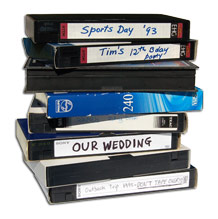
Film, Video, Slides, Photo Transfer Experts since 1986
|
Film & Video Transfer:
(617) 332-3300 |

 Five Benefits of a Professional VHS to DVD Service
Five Benefits of a Professional VHS to DVD Service
Taking your (seemingly) ancient VHS tapes and turning them into shiny, all-digital DVDs can be quite a task. VHS to DVD transfer is no small undertaking, especially if you’re working with decades of footage and dozens, even hundreds of tapes. In most cases, you’re looking at hours and hours of importing, conversion and recording.
Thanks to new software and more powerful computers, pretty much anyone can copy a VHS tape and turn it into a DVD. However, there are some big benefits to letting a professional handle the grunt work.
Benefits like:
Convenience
Most professional VHS to DVD services allow you to simply mail your tapes to their office and wait for the discs to return in the mail. Local shops will have a similar “drop-off and forget” policy, in which you simply leave your VHS tapes in the hands of pros and come back to pick up the DVDs or hard drive (more and more customers are choosing to convert to hard drives) when they’re done. If you’re short on time and don’t feel like spending your weekends in front of a computer screen loading tapes, this is definitely the better way to go.
Quality
You may be savvy with computers, but that doesn’t make you a media transfer expert. Professional services know how to get the highest quality video off a tape and onto a DVD, in the most efficient timespan. While you could spend days simply figuring out what transfer settings work best, a professional service could be hard at work on your project. Pro services also have top-quality, professional gear and software.
Cost
It may sound counter-intuitive, but bringing your VHS tapes to a professional may even end up being cheaper for you in the long run. After you figure in buying the necessary equipment for transferring your VHS tapes to the computer and tracking down some software to do the task, you could be spending more to do it yourself than you would to have someone else handle it. Plus, there’s the opportunity cost—hours spent transferring videos are hours you don’t spend with family or working on hobbies.
Flexibility
Converting tapes on your own provides you with a fairly narrow set of options for what you can do. Depending on your software, you may only be able to convert to DVD, or only to PC shareable media. Talking to an expert can give you options you may not have considered, such as menus, easy sharing capabilities, extra copies and tons of other cool stuff. Pros will also have a number of pricing options so you can figure out what works best for you.
Accountability
Your VHS tapes are precious—they contain irreplaceable memories. So it’s important that you give them to someone that knows what they’re doing. If you accidentally erase, break or damage your tapes trying to convert them, there’s no way to go back. Even if a damaged tape can be salvaged, it will likely cost you more than it would have cost to simply go to a professional for the initial conversion. Nearly all professional services offer quality and safety guarantees.
Overall, how you go about transferring your VHS tapes to DVD or new media is your call. Just be sure to consider the pros and cons to both options available before you commit to one or the other.
Convert VHS to DVD at home

If you’re willing to take the time and effort, with the right gear you can import VHS tapes to your computer yourself. But what, exactly is the “right” gear? It might not be as easy to undertake these conversions as it would be with professional help, but it is totally possible.
If you own a digital video camera, you might already have everything you need to transfer your old VHS tapes directly to your computer. Depending on the DV camera’s make and model, you may be able to import old tapes without any additional hardware or software.
Here’s what you’ll need:
Most of this stuff probably came with your camera, or has been accrued over time. Check your cable drawers! With the gear in tow, here’s how to import those old tapes to your PC:
1. Turn on your DV camera and enable the “DV pass-through” function. Consult your user manual for exact steps on how to get this done.
2. Connect the VCR or VHS camera to your DV camera with the A/V cables. You can also use an S-Video cable, if the correct ports are present.
3. Run a firewire cable between your DV camera and the computer.
4. Turn on the VHS camera or VCR, and then set the DV camera to “Playback.”
5. Once you turn on the two devices, you’ll receive an auto-prompt on your computer screen. Select “Import Video using Windows Import Video.”
6. Name the file and choose a location for the import. You can also select your desired format in this dialog box.
7. Hit “Only import parts of the videotape to my computer,” followed by the “Next” button.
8. Cue the tape on your VHS player and tap “Play.”
9. Click “Start Video Import.” When you have the content you want, hit “Stop Video Import.”
If this sounds to technical or time consuming for you, or if quality if of the utmost importance to you, hand the job over to us here at Play It Again Video. We have been serving our customers for 25 years, and your satisfaction is our priority.




© EverPresent Copyright 2016 | (617) 332-3300 · All Rights Reserved ·
Arlington !
Back Bay !
Belmont !
Boston !
Brighton-Allston !
Burlington !
Cambridge !
Dedham !
Framingham !
Jamaica Plain !
Lexington !
Medford
Milton !
Natick !
Needham !
Newton
! Waltham !
Watertown !
Wayland !
Wellesley !
West Roxbury !
Weston !
Westwood
Copyright © 2025 ·Crystal Theme · Genesis Framework by StudioPress · WordPress · Log in